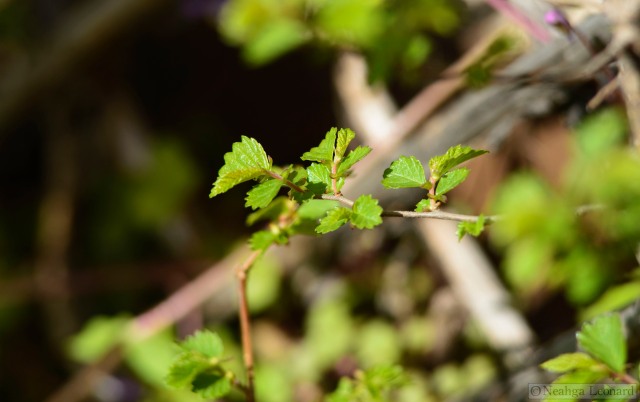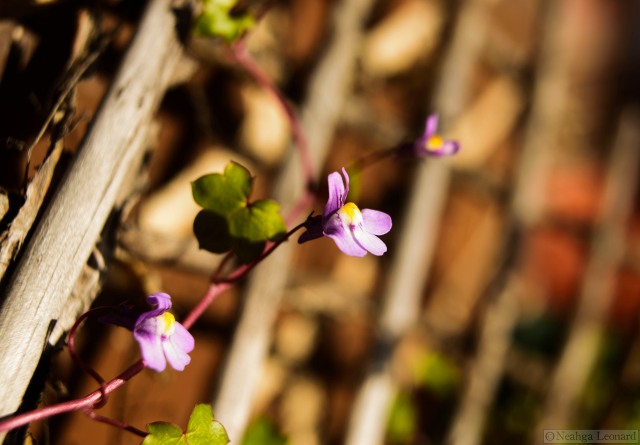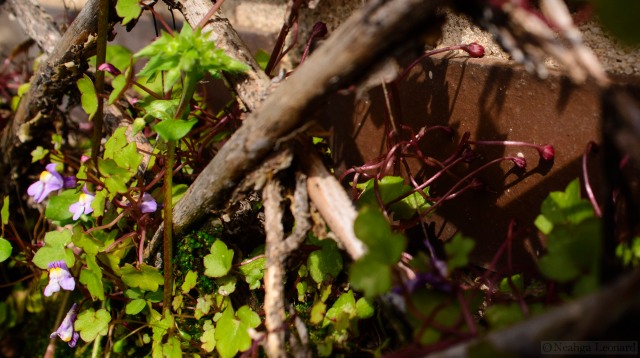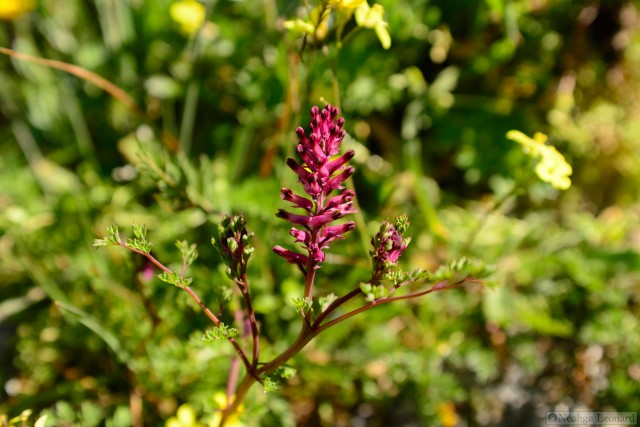Spring is lurching its way through the Northern Hemisphere. In Madrid this year this means more rain than has fallen since the 1940s, usually in a soft drizzle, occasionally spiced with small hail, bouts of hard rain, and periods of epic cloudscapes accompanied by bright sun. It is familiar weather, reminding me of the part of California I grew up in.
In the countryside the effects of all this water are obvious, the land turns green. This is likely to be a good year for farmers and wildflowers, though the former have a globally recognized habit of finding something to complain about no matter the weather. For the wild plants this may mean bountiful seeds next year and the possibility of mast fruiting for woody plants that do that sort of thing (oak trees, I’m looking at you).
Within the boundaries of Madrid, where I have been living recently, the setting is considerably more urban.
In this landscape of stone, cement, and brick the effects of spring are more subtle and easy to overlook; they are most clearly seen in the length and material of coats worn by pedestrians. Long black wool overcoats are being replaced by short black wool overcoats, leather jackets are replacing down, and on the few warmer days some of the women wear skirts with tights and accompanied by peculiar choices in footwear.
Nature-wise the heralds of spring are the street trees which are beginning to leaf out (especially the elms); ornamental cherries, plums, and almonds have been blooming, and, most interestingly to me, the little plants that have adapted to city life are beginning to show signs of life.
On the patio there is a planter box that has been left to what wild nature resides in the city. A small elm has taken root and shows nice bonsai potential. Accompanying the elm are, moss, English Ivy (planted), a few tender oxalis plants, and a small climbing vine with miniscule, but lovely, flowers; purple and white, kissed with egg-yolk yellow.

Leaves and flowers of our mystery plant – the flowers are perhaps half a centimeter across and at most a centimeter long
This plant starts out in a tight cluster and flowers prolifically when conditions are right.
This little plant, Ivy-leaved Toadfax (Cymbalaria muralis) is evergreen and originally native to the Mediterranean region, now found nearly globally, having been introduced both intentionally and inadvertently. The flowers betray the family association; snapdragons or Scrophulariaceae.
Cymbalaria muralis does not suffer from a lack of names, Coliseum-Ivy , Kenilworth-Ivy, Wandering-Sailor, Mother-Of-Thousands, Oxford-Ivy, Pennywort, and Ivy-leaved Toadflax being just a few of its common names.
Ivy-leaved Toadflax prefers calcareous soils and often grows directly from cliffs and older walls. Here in Spain it is a native plant and is as much in balance with its environment as any other plant is in a land so heavily used by humans for so long as the Iberian Peninsula has been. Elsewhere this small plant becomes aggressively invasive and can rapidly form a dense blanket of vegetation over trees, cliffs, and buildings. It is a popular plant for rock gardens.
If a plant could be described as being clever, this plant might qualify for the compliment. It sends runners out in all directions, with most of the ones I have seen pointing upwards.
On a healthy plant these runners can be nearly a meter long and have a fleshy, almost succulent aspect. The leaves and the vines are slightly waxy and smooth to the touch, helping to limit water loss. As it grows, Ivy-leaved Toadflax builds up a dense, nearly light impenetrable, layer of overlapping leaves. Like a forest, this little clump of shade helps to trap both moisture and organic matter. This little reservoir of nutrients feeds the ever growing plant.
The most interesting aspect of this plant is its behavior when it flowers and sets seed. The flowers are pollinated primarily by bees and must be placed where the bees can find and land on them. To ensure this the young flowerbuds are positively phototrophic; they actively seek out the brightest light.
Bees can see into the ultraviolet and to them flowers look very different than to us. I am very curious how these flowers look to the bees.
Once the flower has been pollinated a change takes place and the forming seedpods become negatively phototrophic actively avoiding light. The change can be quite dramatic and rapid
Avoidance of light sends the forming seeds into the darkest places within reach, places where it is more likely to find a safe, damp spot for the small seeds to be deposited.
This clever approach to seed distribution combined with rooting from runners and re-rooting from broken clumps serve the Ivy-leaved Toadflax well. This change in light preference is not unique to Ivy-leaved Toadflax, the common houseplant Monstera deliciosa (aka Swiss Cheese Plant, Window Leaf, Mexican Breafdruit, and many more names) begins life avoiding light, then, when it finds a tree trunk its preference turns towards light as it climbs to the near canopy.
We don’t often talk about the behavior of plants, we usually use more neutral terms such as survival strategy. To us plants are fixed in the landscape with their changes slow. Plants lack of a brain makes discussion of behavior problematic. We often fail to have an appreciation for the senses plants posses and they way their response to stimulus drives their growth and adaptability. We have a prejudice for organisms with a central nervous system, or at least some form of mobility, because they are more similar to ourselves and we find them easier to empathize with.
The little Cymbalaria muralis is far from the only plant in flower right now in Madrid. In the parks Common Fumitory (aka. Earth Smoke), Fumaria officinalis, is blooming.
Common Fumitory is in the Bleeding Heart family, related to Corydalis, Bleeding Hearts, and Squirrel Corn. Often this pretty little plant is lumped into a sub-family of the Poppy family (Papaveraceae).
In some places small fields of Red Campion (Silene dioica) dance in the breeze, making rippling patches of purple-tinged pink.
In the countryside ground dwelling orchids are beginning to bloom, but I have not seen those yet.
Perhaps soon.









It is intriguing as you suggest as to why we don’t speak about plant behaviour and also that of trees, for example. Is this simply down to our technically-enriched lives and our too fast a-paced world. Realising the lengths, certain individuals go to, in order to better our understanding of mammals and birds etc., the lack of effort in getting to know our flora should seem ludicrous. The true naturalists take time to stand and stare and there is a lesson in that for all of us.
That is a good question Tony. It would be interesting to ask people from a pre-industrial society what their views on behavior are. I suppose much of it must come down to the amount of time you spend observing something and whether intentionality can be attributed to it.
The relationship between a climbing or twining plant and it’s host is an interesting one. Twining plants rely on linear structures (wires or other plant stems) to thrive while climbers that send out sucker roots (perhaps such as the lovely Toadfax) seek a flat and textured surface to gain a hold. your photos show a simple wood dowel or cane lattice structure between the ivy-leaf Toadfax the wall. The plant seems not to twine around the trellis structure but weaves between it, which makes me wonder what method it uses to attach itself. Does it have a sucker-root mechanism similar to the ubiquitous (in So. Cal) ficus pumula that attaches to and climbs stucco or cement faced walls at every chance with roots seeking moisture in the cracks and joints? Or does it twine like a Clematis?
Can toadfax achieve a leaf area and density that will positively shade a wall as it matures? I’d be interested to try one in my patio on a three-dimensional wire trellis panel, where vitis california (Rogers Red) performs really well.
The ways climbing plants affix themselves to their substrate is very interesting. Looking at the Ivy-Leaved Toadflax it seems to be an opportunist, using whatever is at hand to brace against as it climbs. There are no special gripping pads like ivy or the Monstera family has, it lack gripping tendrils, and will loosely twine when there is something to wrap around, but in most cases it grows against rock faces. It appears to use leverage and friction, bracing against irregularities in the surface. I’ve seen a few where the vine has fallen down, to no ill effect. The fewer protrusions for the plant to brace against, the shorter the vines seem to be.
I’ve seen some photos of walls completely covered by this plant in a shallow, dense layer. I suspect that it takes a long time for them to reach that density though.